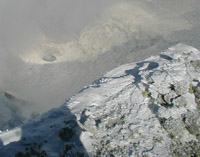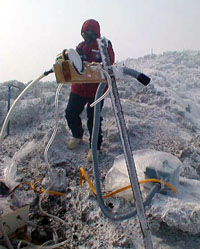|
|

|

|
Looking
down into the lava lake of Erebus.
|
|
|
|
|
Five
senses on Erebus:
|

|
Examining
the heart of the volcano.
by Noel Wanner and Paul Doherty
December
31, 2001
Watch
an infant explore a strange object: they'll look at it intently,
touch it, shake it, put it in their mouths-- almost anything
that will help them determine what this new thing might be.
Scientists, in their quest to undestand the world, are not
so different from an infant in their curiosity; it's the tools
which are different, tools which scientists use to extend
their senses out into ranges far beyond human, to levels of
precision far beyond sense impressions like "this tastes
salty."
During
a two-day blizzard on Mount Erebus, with temperatures near
-35 C (-30 F) and winds over 45 mph (57 kph), creating a wind
chill of -90 F, we had plenty of time to meet the scientists
on Erebus. They were using instruments to extend all of their
senses to explore the geology of Erebus, to try to understand
the "life" of this volcano.
See
:
Rich Esser is the webmaster of the MEVO, Mount Erebus Volcano
Observatory, website. He works with scientist Bill McIntosh
to maintain the live webcamera on the rim of Erebus. The video
images are used by scientists to find the exact time of volcanic
eruptions. The time is used together with seismic data to
probe the structure of the rocks beneath the volcano.
Listen
:
Jeff Johnson is a geologist and mountain climber, he installed
a wide frequency range microphone on the summit cone of Erebus.
This microphone was sensitive in the subsonic frequency range.
These frequencies of sound are emitted during volcanic eruptions,
they do not get absorbed by the air and provide another means
of timing the eruptions.
Taste
:
In the past scientists have done chemical analysis of the
rocks on Erebus. Crystals grow in the magma beneath Erebus
and get spit out of the mountain inside glassy volcanic bombs.
The glass quickly weathers away leaving the mountainside covered
in crystals. Analysis shows that the crystals covering the
mountain are feldspar crystals that are rich in sodium and
potassium, they are also found on Mt. Kenya. These crystals
are coveted by almost everyone at McMurdo Station.
|
|

|

|
Jessie
Crain sets up her "bionic nose".
|
|
|
|
Smell
:
Several scientists were smelling Erebus! Graduate student
Jessie Crain pumped air through filters and collected radioactive
particles and gasses. These radioactive materials are sent
to Paris where they will be placed into particle counters.
The counters will reveal the radioactive isotopes in the plume
of Erebus, and thus tell how long the magma had resided in
the magma chambers beneath the volcano. Graduate student Tina
Calvin plans to fly in a helicopter through the plume of Erebus
to suck up volcanic gasses from the plume and then measure
the carbon dioxide gas concentration in the plume. Carbon
dioxide is one of the crucial "greenhouse gases",
which help to determine the Earth's temperature, so understanding
the roles volcanos play in releasing Co2 is important.
Feel
:
Bill McIntosh is installing new broadband seismometers which
radio their seismic information down to McMurdo Station to
be recorded and forwarded to New Mexico. These seismometers
feel the wavelike vibrations of the surface of the mountain
generated by earthquakes and eruptions. These "seismic
waves" show scientists the internal structure of the
volcano. Bill also got the new wind generators on the mountain
to work, to provide power to the instruments during the long
Antarctic night.
Where
am I?
Inside your inner ear you have sensors which detect
your orientation in space. Undergraduate Emily Desmarais uses
a tool called GPS to perform a similar function, determining
Mt. Erebus' changing position. (GPS stands for Global Positioning
Satellite.) Desmarais has installed GPS recorders around the
mountain. These recorders monitor the position of the outer
surface of the volcano to within a few centimeters (a few
fingerwidths). When the magma chamber beneath the mountain
fills or empties, the surface of the mountain responds, expanding
and contracting, just like your chest bulges out when you
breathe.
The
Brain
In the body all of the sensory signals feed into
the brain to be processed. On Erebus, Professor Phil Kyle
of New Mexico Tech is the principal investigator. He advises
on the science being done by his crew, and then helps them
put together the observations into a picture of the inner
workings of Mt Erebus. Every year the picture gets a little
bit better,but it is never perfect -- so the scientist keep
observing, hoping to learn more.
|

